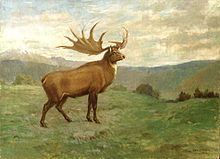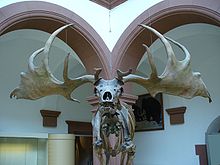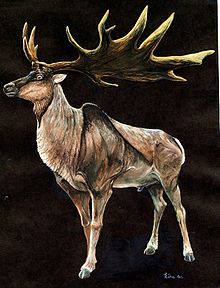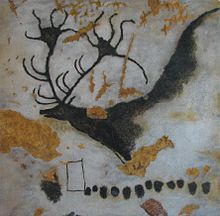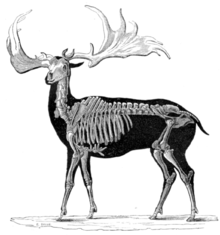- Irish Elk
-
Irish Elk
Temporal range: Middle Pleistocene to Early Holocene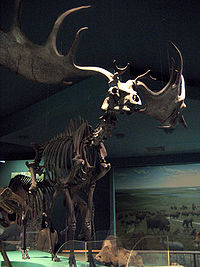
Mounted skeleton at the National Museum of Natural History, Washington, D.C. Scientific classification Kingdom: Animalia Phylum: Chordata Class: Mammalia Order: Artiodactyla Family: Cervidae Genus: †Megaloceros Species: †M. giganteus Binomial name †Megaloceros giganteus
(Blumenbach, 1799)Synonyms †Megaceros giganteus
†Megaloceros giganteus giganteusThe Irish Elk or Giant Deer (Megaloceros giganteus),[1][2] was a species of Megaloceros and one of the largest deer that ever lived. Its range extended across Eurasia, from Ireland to east of Lake Baikal, during the Late Pleistocene. The latest known remains of the species have been carbon dated to about 7,700 years ago.[3] Although most skeletons have been found in Irish bogs, the animal was not exclusively Irish and was not closely related to either of the living species currently called elk - Alces alces (the European elk, known in North America as the moose) or Cervus canadensis (the North American elk or wapiti); for this reason, the name "Giant Deer" is used in some publications.
Contents
Description
Megaloceros giganteus first appeared about 400,000 years ago. It possibly evolved from M. antecedens. The earlier taxon — sometimes considered a paleosubspecies M. giganteus antecedens — is similar but had more complex and compact antlers.
The Irish Elk stood about 2.1 metres (6.9 ft) tall at the shoulders, and it had the largest antlers of any known cervid (a maximum of 3.65 m (12.0 ft) from tip to tip and weighing up to 40 kilograms (88 lb)). In body size, the Irish Elk matched the extant moose subspecies of Alaska (Alces alces gigas) as the largest known deer.[4] A significant collection of M. giganteus skeletons can be found at the Natural History Museum in Dublin.
It should be noted that the Irish Elk does not in any way directly correspond to any living species today, including even the Alaskan moose or North American elk. It is taxonomically a giant and completely extinct deer.[UCMP Berkeley 1]
- ^ Gould, S.J., 1977. "Pp. 79-90 in Ever Since Darwin". The misnamed, mistreated, and misunderstood Irish Elk. W. W. Norton, New York. http://www.ucmp.berkeley.edu/mammal/artio/irishelk.html. Retrieved July 22, 2011.
Evolution of antler size
The size of Irish Elk antlers is distinctive, and several theories have arisen as to their evolution. One theory was that their antlers, under constant and strong sexual selection, increased in size because males were using them in combat for access to females; it was also suggested that they eventually became so unwieldy that the Irish Elk could not carry on the normal business of life and so became extinct. It was not until Stephen Jay Gould's important 1974 essay on Megaloceros that this theory was tested rigorously.
Gould demonstrated that for deer in general, species with a larger body size have antlers that are more than proportionately larger, a consequence of allometry, or differential growth rate of body size and antler size during development. Irish Elk had antlers of just the size one would predict from their body size. This does not mean that sexual selection played no part in maintaining large antler size, only that the antlers of the species' ancestors were already large to begin with. Indeed, Gould concluded that the large antler size and their position on the skull was very much maintained by sexual selection: they were morphologically ill-suited for combat between males, but their position was ideal to present them to intimidate rivals or impress females. Unlike other deer, M. giganteus did not even have to turn its head to present the antlers to best effect, but could accomplish this by simply looking straight ahead.[5]
Extinction
Discussion of the cause of their extinction has focused on the antler size (rather than on their overall body size), which may be due more to their impact on the observer than any actual property. Some have suggested hunting by man was a contributing factor in the demise of the Irish Elk, as may have been the case with other prehistoric megafauna, even assuming that the large antler size restricted the movement of males through forested regions or that it was by some other means a "maladaptation" (see Gould 1974). But evidence for overhunting is equivocal, and as a continental species, it would have co-evolved with humans throughout its existence and presumably have adapted to their presence.
A folk memory of the Irish Elk was once thought to be preserved in the Middle High German word Shelch, a large beast mentioned in the 13th-century Nibelungenlied along with the then-extant aurochs (Dar nach schluch er schiere, einen Wisent und einen Elch, Starcher Ure vier, und einen grimmen Schelch / "After this he straightway slew a Bison and an Elk, Of the strong Wild Oxen four, and a single fierce Schelch."). The Middle Irish word segh was also suggested as a reference to the Irish Elk.[6][7] These interpretations are however, not conclusive.[8][9]
More recent research pointed out that high amounts of calcium and phosphate compounds are required to form antlers, and therefore large quantities of these minerals are required for the massive structures of the Irish Elk. The males (and male deer in general) met this requirement partly from their bones, replenishing them from food plants after the antlers were grown or reclaiming the nutrients from discarded antlers (as has been observed in extant deer). Thus, in the antler growth phase, Giant Deer were suffering from a condition similar to osteoporosis.[10]
When the climate changed at the end of the last glacial period, the vegetation in the animal's habitat also changed towards species that presumably could not deliver sufficient amounts of the required minerals, at least in the western part of its range. The most recent specimen of M. giganteus in northern Siberia, dated to approximately 8,000 years ago - well after the end of the last glacial period - shows no sign of nutrient stress. They come from a region with a continental climate where the proposed vegetation changes had not (yet) occurred.[11]
It is easy to advance a number of hypotheses regarding the disappearance of the more localized populations of this species. The situation is less clear regarding the final demise of the Irish Elk in continental Eurasia east of the Urals. Stuart et al. (2004) tentatively suggest that a combination of human presence along rivers and slow decrease in habitat quality in upland areas presented the last Irish Elk with the choice of either good habitat but considerable hunting pressure, or general absence of humans in a suboptimal habitat.
References
- ^ Geist, Valerius (1998): Megaloceros: The Ice Age Giant and Its Living Relatives. In: Deer of the World. Stackpole Books. ISBN 0-8117-0496-3
- ^ Lister, A.M. (1987): Megaceros or Megaloceros? The nomenclature of the giant deer. Quaternary Newsletter 52: 14-16.
- ^ Stuart, A.J.; Kosintsev, P.A.; Higham, T.F.G. & Lister, A.M. (2004): Pleistocene to Holocene extinction dynamics in giant deer and woolly mammoth. Nature 431(7009): 684-689. PMID 15470427 doi:10.1038/nature02890 PDF fulltext Supplementary information. Erratum in Nature 434(7031): 413, doi:10.1038/nature03413
- ^ http://www.motherearthnews.com/Nature-Community/1989-03-01/Of-Moose-Megaloceros-and-Miracles.aspx
- ^ Gould, Stephen J. (1974): Origin and Function of 'Bizarre' Structures - Antler Size and Skull Size in 'Irish Elk', Megaloceros giganteus. Evolution 28(2): 191-220. doi:10.2307/2407322 (First page text)
- ^ Cuvier, Georges; Edward Griffith et al. (1827). The Animal Kingdom Arranged in Conformity with Its Organization. London: G. B. Whittaker. pp. 87–89. http://books.google.com/?id=3HhIAAAAMAAJ.
- ^ Hibbert, S. (Oct-Apr 1830). "Additional Contributions towards the History of the Cervus Euryce, or Fossil Elk of Ireland". The Edinburgh Journal of Science 2 (3): 314. http://books.google.com/?id=pkYEAAAAYAAJ.
- ^ Owen, Richard (1846). A History of British Fossil Mammals, and Birds. London: John Van Voorst. pp. 461–462. http://books.google.com/?id=pykEAAAAQAAJ.
- ^ Gould, Stephen Jay (June 1974). "The Origin and Function of 'Bizarre' Structures: Antler Size and Skull Size in the 'Irish Elk,' Megaloceros giganteus". Evolution (Society for the Study of Evolution) 28 (2): 191. doi:10.2307/2407322. JSTOR 2407322.
- ^ Moen, R.A.; Pastor, J. & Cohen, Y. (1999): Antler growth and extinction of Irish Elk. Evolutionary Ecology Research 1: 235–249. HTML abstract
- ^ Hughes, Sandrine; Hayden, Thomas J.; Douady, Christophe J.; Tougard, Christelle; Germonpré, Mietje; Stuart, Anthony; Lbova, Lyudmila; Carden, Ruth F.; Hänni, Catherine; Say, Ludovic (2006): Molecular phylogeny of the extinct giant deer, Megaloceros giganteus. Molecular Phylogenetics and Evolution 40(1): 285–291. doi:10.1016/j.ympev.2006.02.004 PDF fulltext. Supplementary data 1, DOC fulltext Supplementary data 2, DOC fulltext Supplementary data 3, DOC fulltext
Further reading
- Kurten, Bjorn (1995): Dance of the Tiger. University of California Press. ISBN 0-520-20277-5.
- Kurten is a paleo-anthropologist, and in this novel he presents a theory of Neanderthal extinction. Irish elk feature prominently, under the name shelk which Kurten coins (based on the aforementioned old German schelch) to avoid the problematic aspects of "Irish" and "elk" as discussed above. The book was first published in 1980, when the name "Giant Deer" was not yet being used widely.
External links
- "Extinct Giant Deer Survived Ice Age, Study Says". N.Geographic. http://news.nationalgeographic.com/news/2004/10/1006_041006_giant_deer.html.
- "CGI picture from "Walking with Beasts"". Discovery Channel. http://dsc.discovery.com/convergence/beasts/photo/slide_05.html. Retrieved February 14, 2006.
- "Megaloceros, Irish elk, Giant deer". BBC. http://www.bbc.co.uk/nature/wildfacts/factfiles/461.shtml. Retrieved October 25, 2005.
- "The Case of the Irish Elk". University of California at Berkeley. http://www.ucmp.berkeley.edu/mammal/artio/irishelk.html. Retrieved October 25, 2005.
Categories:- Prehistoric deer
- Pleistocene mammals
- Prehistoric mammals of Europe
- Prehistoric mammals of Asia
- Pleistocene extinctions
- Megafauna of Eurasia
Wikimedia Foundation. 2010.

